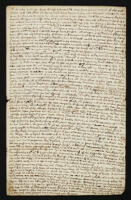A commercially-produced print, numbered 26488 on the image.
Of a similar date to the print on f. 2r.
Four letters: "Refers to I. Newton letter to Sam. Pepys 23 Dec. 1693 bought by R. J. Edleston from F. Barker (who bought it from [?] 'Bibliotheca Phillippica' 4th July -6 July 1892) and later presented by Miss Edleston to Trinity College Library in 1953." - note on second page of Add.Ms.c.1/100.
Edleston, Joseph (1816-1895) Fellow and Bursar of Trinity College CambridgeCopy of a letter from Cotes to Newton dated 18 Aug. 1709 and copy of a letter from Bentley to Cotes undated.
Admy - Commends WW for his defence of Isaac Newton [in the wake of Francis Baily's Life of Flamsteed]: 'a character which is one of the most brilliant spots in the national Glory'.
Allerly by Melrose - DB has read WW's essay on mineralogical classification with much pleasure, and considers it a vast improvement upon Mohs's system [Friedrich Mohs] - 'a provisional system which will soon disappear'. Hopes WW will now devote his time to examining the properties of individual minerals. Could WW send him any unknown information on Isaac Newton to assist him with his biography.
Photograph showing a side view of Newton in the Chapel with the bust of Daniel Lock on the west wall behind and the plaque to James Lambert on the north wall of the Chapel. Printed label at left, "Trinity College Cambridge. Newton's Statue, by Roubiliac. 11" No photographer indicated.
The papers consist of:
Two copies of an annotated typescript catalogue of the Newton library by Heinrich Zeitlinger in 1929, with a later copy of the book list with five more books added by H. M. Adams.
Cuttings about the Newton library dated 1942-1944.
One postcard from Tressilian Nicholas to H. M. Adams and fifteen letters dated August to October 1943 from Henry Sotheran Ltd and from Barnby, Bendall & Co. Ltd. to the Trinity College Librarian H. M. Adams concerning the shipping of the Newton library.
Later notes and letters about the books stored in the Muniments Room and value of the alchemical books in the collection with two letters dated 1943-1944 from Dorothea Waley Singer and John Read to C. D. Broad.
A later note from F. E. Manuel about manuscripts by and about Newton in the British Library, dated June 1957.
614 Ohio St., Vallejo, Calif.; addressed to 'Sir George Trevelyan' as Master of Trinity College. - Is sending Trevelyan a copy of his Wave-Theory Book IX, Part I. 'As you are Master of Newton's College, that alone would make this book of deep interest to you: but there is another reason - namely Newton's Letters to Bentley, 1692, which deal with Cosmogony since the time of Plato...' The book will have 'an appeal to the Historian of Modern Nations'. The cover page 'appeals to Master of Trinity, like Dr Whewell, and therefore is worthy of your careful study'. Asks to hear from Trevelyan when he has read it.
See, Thomas Jefferson Jackson (1866-1962), astronomerNotebook with "Newton Sect: 2. 3." on front cover with "Shepherd, Trin: Coll" at top right. Follows Sections 2 and 3 of vol. I of Newton's Principia, with Propositions and their diagrams followed by Problems.
Shepherd, [?] (fl. 1820s-1830s), member of Trinity CollegeSt. Cloud, nr Worcester. - Has been advised by his friend Dr Howard [Joseph Jackson Howard], Maltravers Herald, to ask Wright for further information regarding Dr Robert Smith. Letters convey information discovered by Smith Carington on Robert Smith and his father John.
Also discussed are Thomas Smith of Holt; 'Clement Smith, alias Nevill, a younger brother of this Thomas' [Senior Bursar of Trinity?]; Dr Thomas Smith, Vice-Master of Trinity; 'Barnabas Smith, Rector of Witham, who married Sir Isaac Newton's Mother'; Elzimar Smith, and Canon Sebastian Smith.
Endorsed 'Being (I suppose) copies by Dr Hook[e], they relating to him. W.D.... Proof of his right to the Hypothesis of the Celestial motions &c'.
Stapleton, near Bristol - Confirms the location of Isaac Newton's rooms. See 'the old Bentley Books' for memoranda on Newton's life. JHM heard the 'disgraceful story of Collier & the garden door' as an undergraduate."
Presents two Isaac Newton books which Newton presented to John Locke: Isaac Newton's Philosophiæ naturalis principia mathematica (London, 1687), Trinity shelfmark Adv.b.1.6 and Opticks (London, 1704), Trinity shelfmark Adv.b.1.16.
Trenton - While WW was defending Isaac Newton in England, FB was also defending him in the USA: 'Nothing could be more contemptible than the attacks of Flamsteed - they refute themselves'.
Endorsements on verso of last sheet: 'Ag[ain]st Newton of Light'; in another hand, 'L[ette]rs between Hook & Newton abt Colours'; 'V.64'; N.P'.
Giving the provenance of a lock of Newton's hair he donated to the College.
Regarding the rooms occupied by Isaac Newton at Trinity, with accompanying photocopied material referred to as 'Exhibits' A-C.
A: 'Appendix C. Sir Isaac Newton's Rooms', from D. A. Winstanley's Early Victorian Cambridge, 1940.
B: 'Newton's Rooms in Trinity' by the Master [E. D. Adrian], from the Trinity Review, [Lent] 1963.
C: 'General Introduction' from D. T. Whiteside's Isaac Newton: The Mathematical Papers, vol. 6, 1974
D: Extract from Willis and Clark, Architectural History of... Cambridge, 1888.
Containing article by John Neu, 'Isaac Newton's Library: Ten Books at Wisconsin', pp. 1-5.


![Answer by Isaac Newton to Robert Hooke [re comments upon his doctrine of light and colours]](/uploads/r/trinity-college-library/8/d/1/8d18a9bf7f546032e792cd150a89da245dc50180ce02d08b8d6e5afbab61119d/O.11a.1.60_thumb.jpg)
![Draft of letter from Robert Hooke to [?] William Brouncker, 2nd Viscount Brouncker](/uploads/r/trinity-college-library/5/0/c/50ca79f4a65c5d25f88697611dd4433bcfd92a1b0732d4668ab7f7ec394e670d/O.11a.1.6_thumb.jpg)